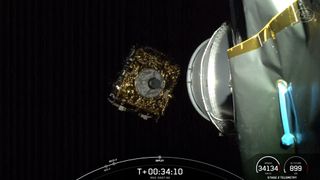SpaceX launched its first-ever mission for the Indian Space Research Organisation (ISRO) today (Nov. 18).
A Falcon 9 rocket carrying ISRO's GSAT-N2 communications satellite lifted off from Cape Canaveral Space Force Station today at 1:31 p.m. EST (1831 GMT). It was the third launch in less than 24 hours for Elon Musk's company.
The Falcon 9's first stage came back to Earth about 8.5 minutes after liftoff as planned, landing on the SpaceX droneship "Just Read the Instructions" in the Atlantic Ocean. It was the 19th mission for this particular booster, according to a SpaceX mission description.

The Falcon 9's upper stage, meanwhile, deployed the 10,360-pound (4,700 kilograms) GSAT-N2 in geosynchronous transfer orbit about 34 minutes after liftoff. The satellite — a project of New Space India Limited, ISRO's commercial arm — will now make its way to geostationary orbit, which lies 22,236 miles (35,786 kilometers) above our planet.
No Indian rocket can carry such a heavy payload to such a distant destination, according to India Today, so ISRO went with the Falcon 9. The decision marked a departure for the Indian space agency, which has generally gone with rockets operated by the European company Arianespace to loft its heaviest satellites.

Once GSAT-N2 is up and running, it "will provide vital services across the country, including internet connectivity for remote areas and in-flight internet services — an area that has recently seen regulatory changes allowing such connectivity in Indian airspace," India Today wrote.
"The satellite is equipped with 32 user beams, including eight narrow spot beams and 24 wide spot beams, which will be supported by hub stations located throughout India," the outlet added.
Get the Space.com Newsletter
Breaking space news, the latest updates on rocket launches, skywatching events and more!
GSAT-N2 has an expected operational life of 14 years.

GSAT-N2's launch was the third for SpaceX in less than a day. The company launched a satellite for the Australian telecom company Optus on Sunday evening (Nov. 17) and lofted a batch of its own Starlink broadband satellites early Monday morning (Nov. 18).
And more spaceflight action is on tap on Tuesday (Nov. 19): SpaceX plans to launch the sixth test flight of its Starship megarocket on Tuesday, during a 30-minute window that opens at 5 p.m. EST (2200 GMT).
Editor's note: This story was updated at 1:50 p.m. ET on Nov. 18 with news of successful launch and rocket landing, then again at 2:10 p.m. ET with news of satellite deployment.
Join our Space Forums to keep talking space on the latest missions, night sky and more! And if you have a news tip, correction or comment, let us know at: community@space.com.

Michael Wall is a Senior Space Writer with Space.com and joined the team in 2010. He primarily covers exoplanets, spaceflight and military space, but has been known to dabble in the space art beat. His book about the search for alien life, "Out There," was published on Nov. 13, 2018. Before becoming a science writer, Michael worked as a herpetologist and wildlife biologist. He has a Ph.D. in evolutionary biology from the University of Sydney, Australia, a bachelor's degree from the University of Arizona, and a graduate certificate in science writing from the University of California, Santa Cruz. To find out what his latest project is, you can follow Michael on Twitter.